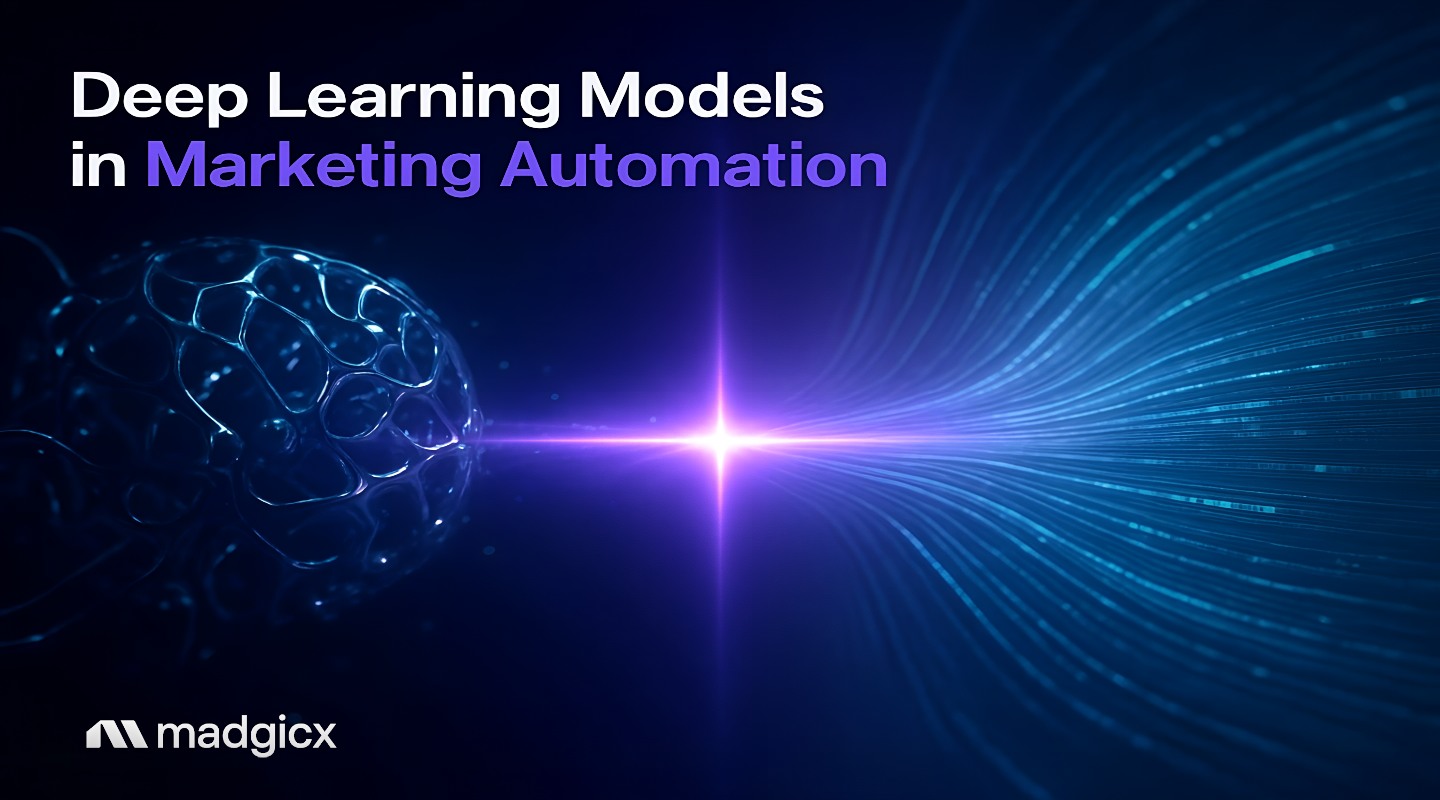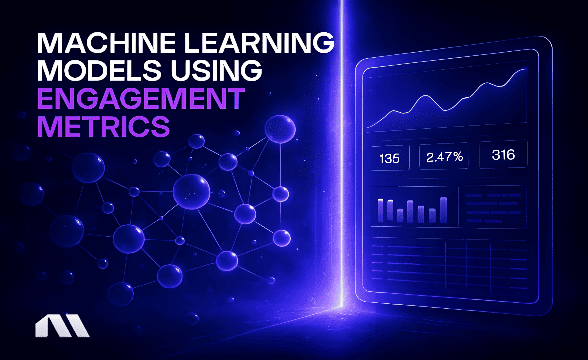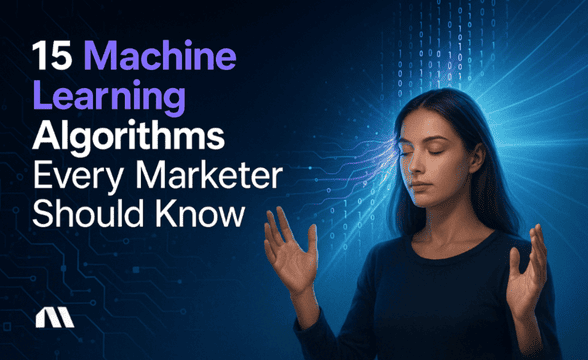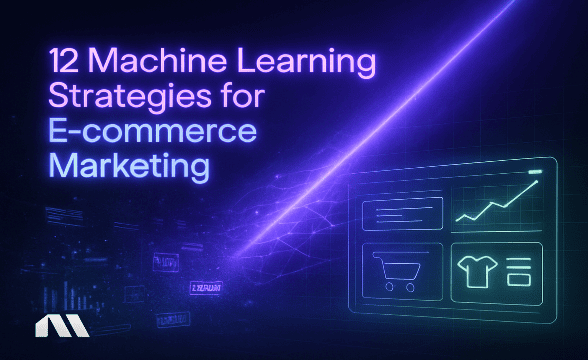Discover how deep learning models in marketing automation deliver higher conversions for e-commerce. Learn strategies, ROI data, and optimization techniques.
Picture this: It's 7 AM, and you're already hunched over your laptop with your morning coffee, diving into yesterday's ad performance. Audience A underperformed again. Creative B needs refreshing. Campaign C burned through budget without a single conversion.
By 10 AM, you've reallocated budgets across five campaigns, paused three underperforming ad sets, and launched two new creative tests.
Sound familiar? You're not alone. Most e-commerce owners spend 15-20 hours per week on manual campaign optimization – time that could be spent actually growing their business.
Here's what's exciting: deep learning models in marketing automation are changing this entire game. We're talking about AI systems that can analyze thousands of customer behavior patterns simultaneously, provide AI-powered optimization recommendations, and deliver results that are designed to improve upon manual management.
According to recent industry data, e-commerce businesses using deep learning models in marketing automation see 77% higher conversion rates compared to traditional manual optimization. Even better? Advertising automation delivers an average ROI of 544%, making it one of the highest-returning investments you can make.
In this guide, we'll break down exactly how deep learning models in marketing automation work for e-commerce advertising, show you the specific tasks they can help optimize (goodbye, 7 AM campaign reviews), and give you a step-by-step roadmap to implement them in your business – no technical degree required.
What You'll Learn
- How deep learning models in marketing automation differ from basic automation and why they matter for e-commerce
- 5 specific ways deep learning models optimize your most time-consuming advertising tasks
- Real implementation steps to get started without technical expertise
- Bonus: ROI calculation framework to project your potential returns
What Are Deep Learning Models in Marketing Automation?
Let's cut through the tech jargon and get to what actually matters for your business. Deep learning models in marketing automation are essentially AI systems that think in layers – imagine having an advertising expert who can simultaneously analyze your customer's purchase history, browsing behavior, social media activity, seasonal trends, and 100+ other signals to help predict what they'll buy next.
Unlike basic automation that follows simple "if this, then that" rules, deep learning models in marketing automation use neural networks that mirror how the human brain processes information. For e-commerce, this means the AI can identify complex patterns in customer behavior that would take a human analyst months to discover.
Here's a practical example: Traditional automation might retarget everyone who visited your product page. Deep learning models in marketing automation analyze that visitor's entire journey – what they clicked first, how long they stayed, what device they used, their previous purchase patterns, and even external factors like seasonality – then provide recommendations for optimal ad creative, timing, and bid amount for that specific person.
Traditional Automation vs. Deep Learning Models in Marketing Automation:
Traditional Automation:
- Rule-based decisions (if/then logic)
- Processes 5-10 data points
- Requires manual rule creation
- Static optimization
- Limited pattern recognition
Deep Learning Models in Marketing Automation:
- Pattern-based decisions (neural networks)
- Processes 100+ data points simultaneously
- Self-learning and adaptive
- Dynamic real-time optimization
- Advanced predictive capabilities
Platforms like Madgicx use deep learning models in marketing automation to analyze Meta audience behavior across multiple touchpoints, helping identify high-value customer segments that manual targeting might miss. The system continuously learns from campaign performance, refining its recommendations to help improve results over time.
Pro Tip: The key difference for e-commerce owners? Traditional automation saves you time on repetitive tasks. Deep learning models in marketing automation provide data-driven campaign optimization recommendations that can improve performance while saving you time. It's not just efficiency – it's enhanced decision-making support.
Deep Learning Models vs. Traditional Marketing Automation
Most e-commerce owners start with basic marketing automation – abandoned cart emails, simple retargeting campaigns, maybe some rule-based bid adjustments. These tools are helpful, but they're essentially following a script you wrote.
Deep learning models in marketing automation flip this entirely. Instead of you telling the system what to do, the system learns what works and provides autonomous recommendations based on real-time data analysis.
Traditional Marketing Automation operates like a very efficient assistant following your instructions. You set up rules: "If someone abandons their cart, send this email after 2 hours." "If cost per acquisition exceeds $50, pause the campaign." "Show this ad to people who visited the product page."
Deep Learning Models in Marketing Automation operate like having a team of expert analysts working 24/7. The system identifies that customers who abandon carts on mobile devices between 2-4 PM are 73% more likely to convert if they see a video ad rather than a static image. It discovers that your lookalike audiences perform better when combined with interest targeting on Tuesdays, but worse on weekends.
The practical difference? Traditional automation might help you maintain current performance with less manual work. Deep learning models in marketing automation typically help improve performance by 15-40% while reducing manual work.
When to Use Each:
Stick with Traditional Automation if:
- You have limited customer data (under 10,000 interactions)
- Your campaigns are simple with clear success patterns
- You prefer full control over every decision
- Budget is extremely limited
Upgrade to Deep Learning Models in Marketing Automation when:
- You have substantial customer data to analyze
- You're scaling beyond what manual optimization can handle
- You want to discover new optimization opportunities
- ROI improvement justifies the investment
For most e-commerce businesses doing over $50K monthly in ad spend, deep learning models in marketing automation become a competitive advantage rather than a nice-to-have feature.
5 Ways Deep Learning Models Optimize E-commerce Marketing Automation
Let's get into the specific ways deep learning models in marketing automation can help streamline your most time-consuming advertising tasks. These aren't theoretical benefits – they're practical optimizations you can implement starting next week.
1. Audience Targeting: Predictive Customer Identification
Remember spending hours building custom audiences, testing different interest combinations, and constantly adjusting targeting parameters? Deep learning models in marketing automation help streamline this entire process by analyzing customer behavior patterns to help predict who's most likely to convert.
Traditional targeting relies on demographics and basic interests. Deep learning models in marketing automation examine behavioral signals: how customers navigate your site, their engagement patterns with different content types, purchase timing, and even external factors like seasonality or trending topics.
Real Example: Madgicx's AI Marketer analyzes over 100 customer Meta signals simultaneously to help identify high-value prospects. One e-commerce client saw a 65% improvement in ROAS after implementing AI-powered targeting recommendations.
The system continuously learns from campaign performance, providing recommendations to expand audiences that convert well and eliminate segments that don't. Instead of testing audience variations for weeks, the AI helps identify optimal targeting opportunities within days.
2. Creative Optimization: Automated A/B Testing at Scale
Creative testing used to mean launching 3-4 ad variations and waiting weeks for statistical significance. Deep learning models in marketing automation transform this into continuous, AI-assisted optimization across dozens of creative elements simultaneously.
The AI analyzes which visual elements, copy variations, and call-to-action buttons perform best for different audience segments. It can generate new creative combinations based on successful patterns, test them against current winners, and help scale the best performers.
Madgicx's AI Ad Generator exemplifies this approach, creating multiple Meta ad variations based on your product images for testing them across different audience segments. The system learns which creative elements resonate with specific customer types, and helps you generate variations optimized for each segment.
Performance Impact: E-commerce businesses typically see 25-40% improvement in creative performance when implementing AI-powered creative optimization recommendations.
3. Budget Allocation: Real-time Spend Optimization
Manual budget management means checking campaign performance daily and redistributing spend based on yesterday's results. Deep learning models in marketing automation provide real-time optimization recommendations based on current performance and predictive modeling.
The system analyzes which campaigns, ad sets, and audiences are most likely to convert at any given moment, providing recommendations to shift budget toward the highest-performing opportunities. It considers factors like time of day, day of week, seasonal trends, and audience behavior patterns.
Instead of moving $500 from Campaign A to Campaign B based on yesterday's performance, the AI predicts which campaigns will perform best in the next few hours and provides budget allocation recommendations accordingly.
Pro Tip: This real-time optimization is particularly powerful during high-traffic periods like Black Friday or product launches, when manual optimization simply can't keep pace with changing conditions.
4. Product Recommendations: Dynamic Personalization
Static product recommendations ("customers who bought this also bought that") are being enhanced by dynamic, AI-powered personalization that adapts to individual customer behavior in real-time.
Deep learning models in marketing automation analyze each customer's browsing patterns, purchase history, and engagement behavior to help predict which products they're most likely to buy next. The system can provide recommendations for adjusting product recommendations, email content, and ad creative based on these predictions.
Business Impact: E-commerce stores using AI-powered product recommendation systems typically see 15-25% increases in average order value and 20-35% improvements in customer lifetime value.
5. Customer Journey Mapping: Multi-touch Attribution and Optimization
Understanding which touchpoints actually drive conversions used to require complex attribution modeling and manual analysis. Deep learning models in marketing automation help map customer journeys and provide optimization recommendations for each touchpoint to maximize conversion probability.
The AI tracks customers across multiple devices and platforms, identifying which combination of touchpoints leads to conversions. It then provides optimization recommendations for each stage of the journey – from initial awareness through post-purchase retention – based on individual customer behavior patterns.
For e-commerce businesses, this means receiving recommendations to optimize the entire funnel rather than individual campaigns in isolation. The system might discover that customers who see a video ad first are more likely to convert from retargeting emails, then provide recommendations to adjust campaign sequencing accordingly.
The ROI Reality: What E-commerce Owners Actually See
Let's talk numbers – the real performance data that matters for your bottom line. While every business is different, industry research shows consistent patterns in deep learning models in marketing automation ROI for e-commerce.
The Big Picture: Marketing automation delivers an average ROI of 544%, making it one of the highest-returning investments available to e-commerce businesses. But here's what that actually looks like in practice.
Conversion Rate Improvements: E-commerce businesses typically see up to 77% higher conversion rates within 90 days of implementing deep learning models in marketing automation. The variation depends on your starting point – businesses with less optimized campaigns see larger improvements.
Targeting Precision: AI-powered audience targeting shows 32% better precision compared to manual targeting methods. This translates to lower customer acquisition costs and higher lifetime value.
Time Savings: The average e-commerce owner saves 15-20 hours per week on campaign management tasks, allowing them to focus on business growth rather than daily optimization.
Implementation Timeline: 76% of businesses see positive returns within the first year, with most seeing initial improvements within 30-60 days.
Realistic Expectations by Timeline:
- 30 Days: Initial optimization improvements, 10-15% performance lift
- 60 Days: Significant pattern recognition, 20-30% improvement in key metrics
- 90 Days: Full system learning, 25-40% overall performance improvement
- 6+ Months: Advanced optimization and scaling, 40%+ improvement potential
The key factor in ROI success? Data quality and volume. Businesses with robust customer data (50,000+ interactions) see faster and more significant improvements than those with limited data sets.
Investment vs. Return: Most e-commerce businesses find that deep learning models in marketing automation platforms pay for themselves within 60-90 days through improved campaign performance alone, before factoring in time savings.
Implementation Roadmap for E-commerce
Ready to implement deep learning models in marketing automation? Here's your step-by-step roadmap, broken down into manageable phases that won't overwhelm your current operations.
Phase 1 (Week 1-2): Assessment and Preparation
Evaluate Your Data Foundation
Start by assessing your current data situation. Deep learning models in marketing automation require substantial customer interaction data to work effectively – minimum 10,000 customer interactions, but 50,000+ for optimal results. Check your:
- Website traffic volume and conversion data
- Email subscriber engagement history
- Social media interaction data
- Existing customer purchase patterns
Identify Your Highest-Value Use Case
Don't try to optimize everything at once. Pick one area where AI assistance will have the biggest impact:
- Customer acquisition (if you're spending $10K+ monthly on ads)
- Customer retention (if you have strong repeat purchase rates)
- Product recommendations (if you have diverse product catalogs)
Review Tool Compatibility
Audit your current marketing stack to understand integration requirements. Most deep learning models in marketing automation platforms integrate with popular e-commerce tools, but planning prevents surprises.
Phase 2 (Week 3-4): Platform Selection and Setup
Compare Your Options
Evaluate managed solutions versus custom development. For most e-commerce businesses, managed platforms offer faster implementation and proven results without technical complexity.
Madgicx Platform Integration
For e-commerce businesses, Madgicx offers comprehensive deep learning models in marketing automation specifically built for online stores. The platform combines AI-powered Meta audience targeting, creative optimization, and campaign management recommendations in one system.
Key integration steps:
- Connect your Facebook and Google ad accounts
- Link your Shopify or WooCommerce store for product data
- Set up conversion tracking and attribution
- Configure initial campaign parameters
Plan Your Integration Timeline
Most e-commerce businesses can complete platform setup within 1-2 weeks, but plan for additional time if you have complex attribution requirements or multiple sales channels.
Phase 3 (Week 5-8): Launch and Initial Optimization
Connect Data Sources
Link all relevant data sources to give the AI maximum learning capability:
- Ad account performance data
- Website analytics and conversion tracking
- Customer relationship management data
- Email marketing performance metrics
Configure Initial Parameters
Start with your best-performing manual campaigns as a baseline, then let the AI provide optimization recommendations from there. Set up your first AI-assisted campaigns with conservative parameters.
Implement Measurement Systems
Establish clear baseline metrics before launching AI optimization. Track:
- Cost per acquisition
- Return on ad spend
- Conversion rates by traffic source
- Customer lifetime value
Phase 4 (Week 9-12): Optimization and Scaling
Analyze Performance vs. Baseline
Compare AI-optimized performance against your manual campaign baselines. Most businesses see initial improvements within 2-4 weeks, with significant gains by week 8-12.
Refine and Expand
Based on initial results, expand successful optimization to additional campaigns and product lines. The AI's learning improves with more data, so scaling typically improves performance.
Advanced Feature Implementation
Once basic optimization is working well, implement advanced features like:
- Cross-platform campaign coordination
- Advanced attribution modeling
- Predictive customer lifetime value optimization
Pro Tip: The key to successful implementation? Start small, measure everything, and scale based on proven results rather than trying to optimize everything immediately.
Choosing the Right Deep Learning Platform
Not all AI marketing platforms are created equal, especially for e-commerce businesses. Here's how to evaluate your options and choose the platform that'll actually move your revenue needle.
Platform Comparison Matrix:
Madgicx (E-commerce Focused)
- Strengths: Built specifically for e-commerce, combines AI creative generation with campaign optimization, deep Shopify integration
- Best For: Online stores wanting comprehensive optimization
- Pricing: Scales with ad spend, ROI-focused pricing
Bloomreach (Enterprise)
- Strengths: Advanced personalization, email integration
- Best For: Large e-commerce businesses with complex needs
- Pricing: Enterprise-level investment required
Generic Marketing Automation Platforms
- Strengths: Broad feature sets, established market presence
- Best For: Businesses needing basic automation across multiple channels
- Pricing: Varies widely
Key Evaluation Criteria for E-commerce:
E-commerce Integration Depth: Does the platform understand product catalogs, inventory levels, and seasonal trends? Madgicx excels here with Shopify reporting integration.
Creative Automation: Can the platform generate and test ad creative automatically? This is crucial for scaling e-commerce campaigns without hiring large creative teams.
Attribution Accuracy: How well does the platform track conversions across devices and touchpoints? E-commerce businesses need accurate attribution to optimize profitably.
Learning Speed: How quickly does the AI adapt to your specific business patterns? Faster learning means quicker ROI.
For most e-commerce businesses, Madgicx offers the best combination of e-commerce-specific features and proven results. The platform's unique combination of AI creative generation and deep learning models in marketing automation makes it particularly effective for online stores looking to scale efficiently.
Decision Framework:
- Under $5K monthly ad spend: Start with basic automation tools
- $5K-$25K monthly ad spend: Madgicx or similar e-commerce-focused platforms
- $25K+ monthly ad spend: Consider enterprise solutions or advanced Madgicx features
The right platform should feel like it was built specifically for your type of business, not a generic solution you're trying to adapt.
Common Mistakes and How to Avoid Them
After working with hundreds of e-commerce businesses implementing deep learning models in marketing automation, we've seen the same mistakes repeatedly. Here's how to automate ad campaigns with AI while avoiding the pitfalls that derail most implementations.
Mistake #1: Starting Too Broad
Many businesses try to optimize everything simultaneously – audience targeting, creative optimization, budget allocation, and email marketing all at once. This overwhelms both the AI system and your team.
Solution: Pick one high-impact area and master it before expanding. Many successful implementations start with audience targeting or creative optimization, then add additional optimization once the first system is performing well.
Mistake #2: Insufficient Data Preparation
Launching deep learning models in marketing automation with poor data quality is like trying to teach someone to drive while blindfolded. The AI can only provide recommendations as good as the data it learns from.
Solution: Spend time cleaning your customer data, ensuring proper tracking implementation, and establishing baseline metrics before launching AI optimization. Our guide on machine learning models using advertising data covers data preparation in detail.
Mistake #3: Unrealistic Timeline Expectations
Some businesses expect immediate transformation – 50% improvement in week one. Deep learning models in marketing automation require time to analyze patterns and provide optimization recommendations.
Solution: Plan for 30-60 days of learning period before expecting significant improvements. Initial gains often appear within 2-4 weeks, but major optimization takes 2-3 months.
Mistake #4: Ignoring Baseline Measurement
Without proper baseline metrics, you can't measure the true impact of AI optimization. Many businesses implement automation without knowing their starting performance.
Solution: Document current performance across all key metrics before implementing any optimization. This includes cost per acquisition, conversion rates, customer lifetime value, and time spent on manual optimization.
Mistake #5: Over-relying on Automation
Deep learning models in marketing automation are powerful, but they're not magic. Some businesses implement AI then completely stop monitoring campaign performance, assuming the system will handle everything.
Solution: Maintain strategic oversight while letting AI handle tactical optimization recommendations. Review performance weekly, but avoid daily micro-management that interferes with the learning process.
Pro Tip: The most successful implementations balance AI automation with human strategic oversight. Let the AI handle the data analysis and tactical optimizations, while you focus on strategic decisions and creative direction.
FAQ Section
How much data do I need to start with deep learning models in marketing automation?
Minimum 10,000 customer interactions for basic functionality, but 50,000+ interactions provide optimal results. This includes website visits, email opens, social media engagement, and purchase data. If you're below the minimum, focus on data collection for 2-3 months before implementing deep learning optimization.
Will this replace my current marketing tools?
Deep learning models in marketing automation platforms integrate with existing tools rather than replacing them. For example, Madgicx works alongside your Facebook Ads Manager, Google Analytics, and Shopify for your marketing. The AI enhances your current tools' capabilities rather than requiring a complete platform overhaul.
How long before I see results?
Initial improvements typically appear within 2-4 weeks as the AI begins identifying optimization opportunities. Significant gains usually develop by 90 days once the system has sufficient data to make advanced optimization recommendations. Our research on machine learning in performance marketing shows detailed timeline expectations.
Is this too technical for small e-commerce businesses?
Modern platforms like Madgicx handle the technical complexity behind user-friendly interfaces. No coding or data science expertise required. The platforms are designed for business owners, not technical specialists. Setup typically takes 1-2 weeks with guided onboarding.
What if my current campaigns are already profitable?
Deep learning models in marketing automation typically help improve profitable campaigns by 15-40% additional conversion lift. The AI helps identify optimization opportunities that manual management might miss, even in well-performing campaigns. Many successful businesses use deep learning to scale profitable campaigns more efficiently rather than fix broken ones.
Your Next Step Toward AI-Optimized Marketing Success
Here's the reality: while you're manually optimizing campaigns every morning, your competitors are implementing AI systems that provide optimization recommendations 24/7. The businesses that adopt deep learning models in marketing automation now will have a significant competitive advantage as these technologies become standard.
The transformation doesn't happen overnight, but it's more accessible than ever. You don't need a technical team or massive budget – you need the right platform and a systematic approach to implementation.
Start with one high-impact use case. For most e-commerce businesses, that's either audience targeting optimization or creative optimization. Get that working well, measure the results, then expand to additional areas based on proven ROI.
The time you save on manual optimization can be reinvested in strategic business growth – product development, customer experience improvements, or market expansion. That's the real value of deep learning models in marketing automation: not just better campaign performance, but freeing you to focus on what actually grows your business.
Advanced machine learning models in advertising tech are no longer just for enterprise companies. E-commerce businesses of all sizes can access these capabilities through platforms specifically built for their needs.
Your next step? Evaluate your current data situation, identify your highest-impact use case, and choose a platform like Madgicx that's built for e-commerce success. The sooner you start, the sooner you'll be competing with AI-powered optimization rather than against it.
Madgicx's deep learning models help streamline Meta campaign optimization while you focus on growing your business. Join thousands of e-commerce owners saving 15+ hours per week with AI-assisted optimization.
Digital copywriter with a passion for sculpting words that resonate in a digital age.







.avif)







